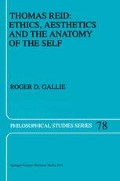Abstract
The first section of our first chapter is about the place of sensation or feeling in sense perception. In Reid’s view sense perception and moral assessment are alike. But they are not alike because sensation or feeling predominate in both as in Hume. Indeed, as far as Reid is concerned, an adequate role for sensation in sense perception is hard to find. For one thing genuine sensations are not representations. In section II the way Reid distinguishes between the notions of primary and of secondary qualities in terms of their different relations to sensation is set out. In section III we ask whether there really are visual sensations as far as Reid is concerned.
Access this chapter
Tax calculation will be finalised at checkout
Purchases are for personal use only
Preview
Unable to display preview. Download preview PDF.
Notes
Recall Wittgenstein, Philosophical Investigations, Second edition, Blackwell 1958, Part I, section 311: “What difference could be greater?” — In the case of pain I believe that I can give myself a private exhibition of the difference. But I can give anyone an exhibition of the difference between a broken and an unbroken tooth. — But for the private exhibition you don’t have to give yourself actual pain; it is enough to imagine it — for instance you screw up your face a bit. And do you know that what you are giving yourself this exhibition of is pain and not, for example, a facial expression? And how do you know what you are to give yourself an exhibition of before you do it? This private exhibition is an illusion.
See for example Vere Chappell’s ‘The Theory of Sensations’ in Dalgarno and \ Matthews eds., The Philosophy of Thomas Reid, Kluwer 1989, pp49–63.
Thus Lehrer’s worry in his Thomas Reid, Routledge 1989, chapter XI about there being a severe discrepancy between the account of the formation of conceptions in Intellectual Powers V and the account of how our conceptions of certain primary qualities arise in Inquiry V may be largely unreal. For an assessment of Lehrer’s account of Reid’s position on concept formation in the Intellectual Powers see my ‘Lehrer on Reid on General Conceptions’, The British Journal for the History of Philosophy, Volume 1, No.2 1993, ppl25–38.
See Paul Wood, ‘David Hume on Thomas Reid’s An Inquiry into the Human Mind on the Principles of Common Sense: A New Letter to Hugh Blair from July 1762’, Mind 95 (1986) pp411–16. The text of the letter is given in full.
See my Thomas Reid and ‘The Way of Ideas’, Kluwer 1989, chapter 4, section 2 for more on this topic.
For a good discussion of this topic see Norman Daniels, ‘Thomas Reid’s Discovery of Non-Euclidean Geometry’, Philosophy of Science 39, 1972, pp219–37.
See Godfrey Vesey, ‘Of the Visible Appearances of Objects’ in ed. J. Fisher, Perceiving Artworks, Philadelphia 1980, pp42–58.
See John Smith III, Commonsense Faculty Psychology: Reidian Foundations for Computational Cognitive Science, PhD dissertation, Department of Philosophy, University of Arizona, 1985. I would echo Lehrer’s endorsement of the interest and importance of this kind of approach to the interpretation of Reid. But this is not to say that such an approach is beyond criticism in certain important respects.
Author information
Authors and Affiliations
Rights and permissions
Copyright information
© 1998 Springer Science+Business Media Dordrecht
About this chapter
Cite this chapter
Gallie, R.D. (1998). Perception, Sensation and First Principles — The Ingredients of a Sense. In: Thomas Reid: Ethics, Aesthetics and the Anatomy of the Self. Philosophical Studies Series, vol 78. Springer, Dordrecht. https://doi.org/10.1007/978-94-015-9020-4_1
Download citation
DOI: https://doi.org/10.1007/978-94-015-9020-4_1
Publisher Name: Springer, Dordrecht
Print ISBN: 978-90-481-5095-3
Online ISBN: 978-94-015-9020-4
eBook Packages: Springer Book Archive

